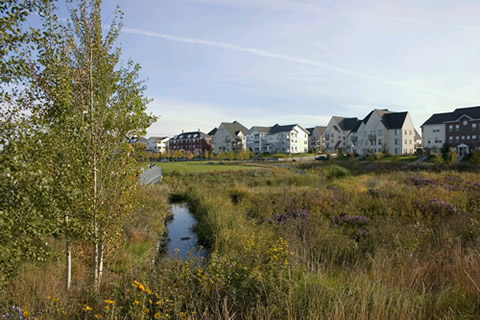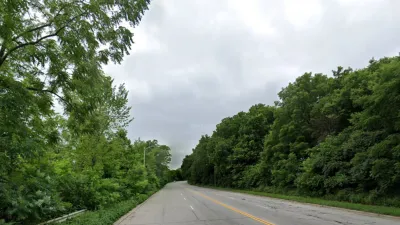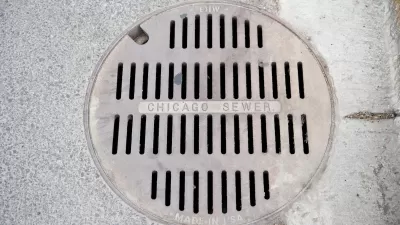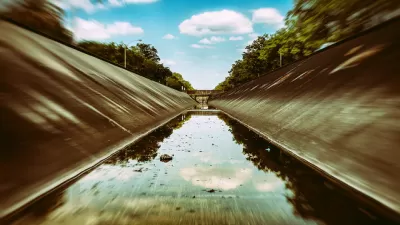According to the Census Bureau, the United States will have over 400 million people by 2040. How will population growth – 100 million more Americans over the next three decades – impact the quality of your environment? The answer will depend on the choices we make as a society, says James A. LaGro, Jr.
Challenges Ahead

The Obama administration and Congress intend to create a massive economic stimulus package to reinvest in America's "gray infrastructure." Attending to deferred maintenance on bridges and highways is needed in many communities, along with remedial reconstruction to improve both the mobility and safety of pedestrians and bicyclists. Also long overdue are strategic upgrades to reduce environmental impacts from the nation's electricity, water, and sanitary infrastructure – and to increase the efficient use of energy and water. These challenges will require substantial investment for several years.
Policy makers must not neglect, however, the progressive decline of nature's infrastructure.
Nature's infrastructure is the air, water, soil, plants, animals, and microbes that – working together in ecosystems – provide everything that we humans need to survive on this planet. Trees, for example, remove carbon dioxide and add oxygen to the air we breathe through photosynthesis. And soils – which are teeming with microorganisms – help detoxify the water pollutants that are continually disposed into the environment.
But there are limits to the amount of pollution the environment can absorb without reducing ecosystem services and impairing both human health and the sustainability of our economy.
Population Growth and Environmental Change
The U.S. population doubled in the past six decades, growing from 151 million in 1950 to about 304 million people today. During this period, millions of acres of forests, grasslands, and wetlands in America were converted to urban, suburban, and exurban development. This unprecedented expansion of the built environment – with relatively little attention paid to its sustainability – eradicated countless natural areas and fragmented natural corridors that linked many of the remaining terrestrial and aquatic ecosystems. Today, these ecosystems are more isolated from each other – and less buffered from both human and non-human disturbances.
More than 80 percent of America's population now lives in the nation's cities and suburbs. According to the U.S. Geological Survey, about 16,000 kilometers (10,000 miles) of paved roads and one million new homes were built, annually, in recent years. These impervious surfaces – and many of our largest metropolitan areas – are concentrated in watersheds supporting the nation's major rivers and estuaries. Because of this proximity, aquatic ecosystems – and municipal water supplies – are at risk. And those risks are growing.

Investing in Nature's Infrastructure
Whether within a city, suburb, or rural farm – many land uses produce negative externalities that impose off-site environmental and economic impacts. Common off-site impacts are pollutants – air emissions from exhaust pipes and contaminant-laden storm water runoff from constructed impervious surfaces. These and many other pollutants degrade ecosystem structure and function – the air, water, soil, and biota that sustain us.
Investing, now, in nature's infrastructure could reverse decades of environmental degradation while creating thousands of new green-collar jobs to bring our human habitats more in harmony with nature. This federal interagency initiative would advance several of Obama's policy priorities, including energy conservation, environmental protection, and public health.
Global climate change heightens the risks of adhering to a "business as usual" – and resource consumptive – 20th century paradigm. And yet relatively few public policy makers have responded adequately to the scientific evidence. Federal, state, and local policies continue to encourage development and other land use practices that imperil environmental quality and community viability.
For example, in the Chesapeake Bay – the nation's largest estuary – collapsing crab and oyster fisheries result from land use practices in the built environment and on adjoining agricultural landscapes. The Bay's fisheries and seafood industry are declining, in part, because of nutrient-laden runoff from chicken and pig farms.
Another culprit is poorly designed urban and suburban development – buildings, parking lots, streets, and highways that treat rain water as a waste product, rather than as a valuable natural resource.
Many of the nation's largest cities – including Washington D.C. – also spill tons of raw sewage into the nation's waterways during heavy rain storms and snow melts. Combined storm and sanitary sewers exist in nearly 800 cities – mostly in the Northeast, Great Lakes region, and the Northwest. These combined sewer overflows (CSOs) adversely impact once-productive aquatic ecosystems and the regional economies dependent on these natural resources.
Correcting Past Mistakes
America's shopping malls, commercial strips and office complexes typically have too few trees, too little green space, and vast unbroken expanses of impervious pavement that shed rather than conserve rain water. Studies by the non-profit Center for Watershed Protection show that aquatic ecosystems are significantly impacted when just 10 percent of a contributing watershed's surface is developed impervious area.
The good news is that streets and parking lots can be retrofitted. Low-impact design can reduce "effective" imperviousness and substantially decrease the built environment's hydrologic and ecological impacts. Greened streets have pervious pavement – and are bordered by shade trees and bio-infiltration swales, or rain gardens, that filter storm runoff and allow rainwater to percolate into the ground.
Highways can be greened, too, by planting medians and rights-of-way with native species of trees, grasses and wildflowers. With nearly 47,000 miles of interstate highways, and many more miles in state and county highways, eliminating mowing on thousands of acres would cut carbon emissions and help reestablish habitat connectivity – creating vital ecological "bridges" for species displaced by the road building, nearby development, and, potentially, a changing climate.
Protecting environment quality requires much more than public green space – although parks and greenways are important elements in nature's infrastructure. Individual trees, for example, help clean our air, create habitat for insects and birds, and provide other valuable ecological services. By moderating micro-climates near homes and other buildings, trees also reduce the energy demand for air conditioning.
Buildings account for about 40 percent of both the energy consumed and carbon dioxide emitted in the United States, according to the Department of Energy. Green roofs – a good example can be found on Chicago's City Hall – employ an insulating layer of plants and soil that reduces heating and cooling costs and harvests rain water which would otherwise flow into nearby sewers. They also can provide useable outdoor space – above the noise and fumes of congested streets. Green roofs help cool cities in summer, too, by reducing the urban heat island effect. Chicago offers grants and New York City now offers property tax credits to spur green roof retrofits. These programs should be models for the rest of the country.
Green buffers are another important element in restoring nature's infrastructure. Ecologically healthy shores and riparian areas control erosion, detoxify pollutants, and provide needed refuge for biodiversity. Greener, more natural approaches to managing riparian zones – protected, ideally, with conservation easements – can reduce the quantity and improve the quality of storm runoff entering our nation's surface waters.
Public Policy Reform
Government – at federal, state and local levels – must lead by example. The federal government is the nation's largest real estate holder, and the U.S. General Service Administration's sustainable design program for public buildings and sites is making a difference. But policy makers must also reevaluate and reform the policies that overtly – and, perhaps, inadvertently – encourage unsustainable development. Federal transportation and housing policies – expressed, in part, by the U.S. tax code – and state and local land development standards are good places to start.
Polluter Pays
Simple but effective policy options can reduce air and water pollution and protect public health, safety, and welfare. One, for example, is a new pollution tax on gasoline and diesel fuels. Engines in vehicles, lawn mowers, leaf blowers, and other machinery burn fossil fuels, create pollutants that foul air and water quality, and contribute to climate change. Not a user fee, or even a carbon tax, this pollution tax would generate revenue to revitalize nature's infrastructure. Even a 10 cent per gallon pollution tax would generate billions of dollars each year for environmental restoration.
The federal fuels tax, currently 18.4 cents per gallon, has remained unchanged since 1993. Federal fuel taxes currently go to the federal Highway Trust Fund to support the nation's highway system. State fuels taxes vary, but average about 28 cents per gallon of gasoline and slightly less for diesel. Any fuels tax is regressive, so for those with the lowest incomes, this tax could be off-set by lower payroll taxes.
The purpose of a pollution tax is simple: to internalize the costs of an activity's negative externalities (in this case, air and water pollution from burning petroleum-based fuels). Over time, these environmental restoration funds could purchase riparian conservation easements, pay for a wide range of ecological restoration projects, and create incentives for retrofitting the built environment.
A 21st Century Paradigm
A national initiative to invest in nature's infrastructure could be a public-private partnership, providing technical assistance, financial incentives and disincentives, and workforce training.
Thousands of green-collar workers could be trained to retrofit highways, streets, and parking lots, restore hundreds of miles of shorelines and riparian corridors, and in various ways mend nature's battered infrastructure. This rebuilding program could employ recent college graduates, "downsized" factory workers, and returning veterans, guided by teams of environmental planners, landscape architects, ecologists, arborists and others.
Investing in nature's infrastructure could be transformative – advancing America's 21st century economy while making our communities healthier and more resilient to climate change. And by revitalizing our nation's streams, rivers, lakes, bays and estuaries, this initiative would bring our human habitats more in harmony with nature.
Finally, investing in nature's infrastructure would also build human capital through meaningful work on a worthy national purpose – creating a healthy, prosperous, and sustainable future.

Planetizen Federal Action Tracker
A weekly monitor of how Trump’s orders and actions are impacting planners and planning in America.

Congressman Proposes Bill to Rename DC Metro “Trump Train”
The Make Autorail Great Again Act would withhold federal funding to the system until the Washington Metropolitan Area Transit Authority (WMATA), rebrands as the Washington Metropolitan Authority for Greater Access (WMAGA).

DARTSpace Platform Streamlines Dallas TOD Application Process
The Dallas transit agency hopes a shorter permitting timeline will boost transit-oriented development around rail stations.

Renters Now Outnumber Homeowners in Over 200 US Suburbs
High housing costs in city centers and the new-found flexibility offered by remote work are pushing more renters to suburban areas.

The Tiny, Adorable $7,000 Car Turning Japan Onto EVs
The single seat Mibot charges from a regular plug as quickly as an iPad, and is about half the price of an average EV.

Supreme Court Ruling in Pipeline Case Guts Federal Environmental Law
The decision limits the scope of a federal law that mandates extensive environmental impact reviews of energy, infrastructure, and transportation projects.
Urban Design for Planners 1: Software Tools
This six-course series explores essential urban design concepts using open source software and equips planners with the tools they need to participate fully in the urban design process.
Planning for Universal Design
Learn the tools for implementing Universal Design in planning regulations.
Municipality of Princeton
Roanoke Valley-Alleghany Regional Commission
City of Mt Shasta
City of Camden Redevelopment Agency
City of Astoria
Transportation Research & Education Center (TREC) at Portland State University
US High Speed Rail Association
City of Camden Redevelopment Agency
Municipality of Princeton (NJ)





























